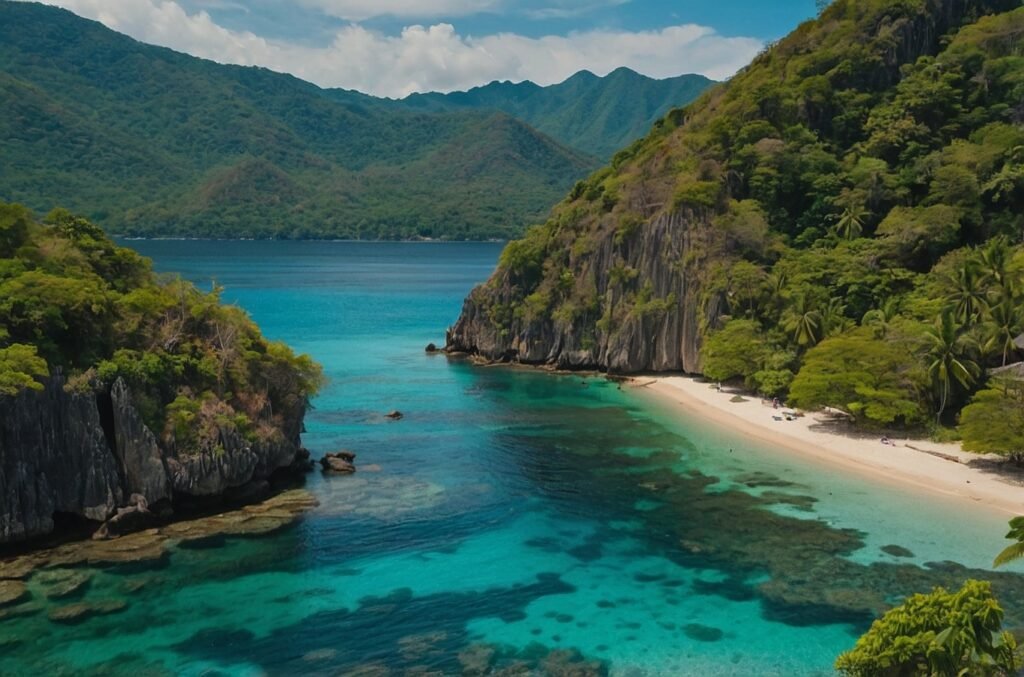The Philippines, an archipelagic nation in Southeast Asia, boasts a rich cultural heritage and diverse natural resources. This diversity is reflected in its national symbols, each representing a unique aspect of Filipino identity, history, and natural abundance. From the mighty carabao to the sweet mango, these symbols serve as powerful representations of the nation’s spirit and character. This comprehensive exploration delves into the significance, history, and cultural importance of various Philippine national symbols, offering readers a deeper understanding of the country’s identity through these iconic emblems.
The Philippine Flag: A Testament to Valor and Peace
The Philippine flag stands as the most recognizable and important national symbol. Designed by General Emilio Aguinaldo and first unfurled on June 12, 1898, the flag embodies the nation’s struggle for independence and its aspirations for the future.
Design and Symbolism
The flag consists of two equal horizontal bands of blue (top) and red, with a white equilateral triangle at the hoist side. Within the triangle is a golden sun with eight rays, each representing the first eight provinces that revolted against Spanish colonial rule. Three five-pointed stars, one at each corner of the triangle, symbolize the three major island groups of the Philippines: Luzon, Visayas, and Mindanao.
The colors of the flag hold deep meaning:
- Blue represents peace, truth, and justice
- Red symbolizes patriotism and valor
- White signifies liberty, equality, and fraternity
Historical Significance
The Philippine flag has undergone several modifications since its inception, reflecting the country’s tumultuous journey towards independence. During the American colonial period, the display of the flag was prohibited, only to be officially readopted upon the granting of Commonwealth status in 1935. Today, the flag serves as a powerful symbol of national unity and pride, flown at government buildings, schools, and during official ceremonies.
The Philippine Eagle: Majestic Guardian of the Forests
Declared the national bird in 1995, the Philippine Eagle (Pithecophaga jefferyi) is a magnificent raptor endemic to the Philippines. This critically endangered species embodies the country’s rich biodiversity and the urgent need for conservation efforts.
Physical Characteristics
- Wingspan: Up to 2 meters (6.6 feet)
- Height: 86-102 cm (34-40 inches)
- Weight: 4.7-8 kg (10.4-17.6 lbs)
The Philippine Eagle is known for its distinctive appearance, featuring a shaggy crest, massive hooked beak, and powerful talons. Its plumage is predominantly brown and white, with a pale face and dark eye patches.
Ecological Importance
As an apex predator, the Philippine Eagle plays a crucial role in maintaining ecological balance in its forest habitat. Its presence indicates a healthy ecosystem, making it an important indicator species for conservation efforts.
Conservation Status
The IUCN Red List classifies the Philippine Eagle as critically endangered, with an estimated population of only 180-500 mature individuals remaining in the wild. Threats to its survival include:
- Deforestation
- Hunting
- Human encroachment on habitat
- Climate change
Conservation initiatives, such as the Philippine Eagle Foundation, work tirelessly to protect this majestic bird and its habitat through breeding programs, habitat restoration, and public education.
The Sampaguita: A Fragrant Symbol of Purity
Officially designated as the national flower in 1934, the Sampaguita (Jasminum sambac) holds a special place in Filipino culture. This small, white flower is renowned for its sweet fragrance and delicate beauty.
Cultural Significance
The Sampaguita is deeply ingrained in Filipino traditions and daily life:
- Garlands: Often strung into garlands to welcome guests or honor individuals
- Religious offerings: Used in Catholic and Buddhist rituals
- Perfumes and cosmetics: Prized for its aromatic properties
- Traditional medicine: Used in folk remedies for various ailments
Symbolism
The Sampaguita represents:
- Purity
- Simplicity
- Humility
- Strength
Its ability to bloom even in challenging conditions symbolizes the resilience of the Filipino spirit.
Cultivation and Care
| Aspect | Details |
|---|---|
| Scientific Name | Jasminum sambac |
| Family | Oleaceae |
| Native Range | South and Southeast Asia |
| Bloom Time | Year-round in tropical climates |
| Preferred Soil | Well-draining, slightly acidic |
| Sunlight Requirement | Full sun to partial shade |
| Watering Needs | Regular, moderate watering |
The Narra: Towering Symbol of Strength
The Narra tree (Pterocarpus indicus), declared the national tree in 1934, stands as a symbol of strength, resilience, and the natural beauty of the Philippines.
Characteristics
- Height: Up to 40 meters (130 feet)
- Trunk Diameter: Up to 2 meters (6.6 feet)
- Lifespan: Can live for several centuries
The Narra is known for its strong, durable wood, which ranges in color from yellow to deep red. Its wide, spreading canopy provides excellent shade, making it a popular choice for parks and urban landscaping.
Ecological and Economic Importance
- Habitat: Provides shelter and food for various wildlife species
- Soil Improvement: Nitrogen-fixing capabilities enrich the soil
- Timber: Highly valued for furniture and construction
- Traditional Medicine: Bark and leaves used in folk remedies
Conservation Status
The Narra is classified as vulnerable by the IUCN due to overexploitation and habitat loss. Conservation efforts focus on reforestation programs and sustainable harvesting practices to ensure the survival of this iconic species.
The Carabao: Humble Beast of Burden
The Carabao, or water buffalo (Bubalus bubalis carabanesis), holds the distinction of being the national animal of the Philippines. This gentle giant has played a crucial role in Philippine agriculture and rural life for centuries.
Physical Characteristics
- Weight: 400-900 kg (880-1,980 lbs)
- Height: 1.2-1.5 meters (4-5 feet) at the shoulder
- Lifespan: 18-20 years in the wild, up to 40 years in captivity
Carabaos are characterized by their large, curved horns, dark gray to black color, and sparse hair. They are well-adapted to hot, humid climates and are excellent swimmers.
Cultural and Economic Significance
The Carabao’s importance in Philippine society is multifaceted:
- Agriculture: Essential for plowing fields and transporting crops
- Transportation: Used to pull carts in rural areas
- Food Source: Meat and milk are consumed, with carabao milk used to make traditional sweets
- Cultural Symbol: Featured in festivals, folk tales, and art
Carabao in Modern Philippines
While mechanization has reduced the Carabao’s role in agriculture, efforts are being made to preserve its cultural significance and explore new economic opportunities:
- Carabao-based tourism activities
- Development of carabao dairy industry
- Conservation of native Carabao breeds
The Anahaw: Palm of Nobility
The Anahaw (Saribus rotundifolius), also known as the Fountain Palm, was declared the national leaf of the Philippines in 1934. This elegant palm species has both practical and symbolic importance in Filipino culture.
Botanical Description
- Height: Up to 20 meters (65 feet)
- Leaf Shape: Fan-shaped, circular
- Leaf Diameter: Up to 1.5 meters (5 feet)
The Anahaw’s large, round leaves are its most distinctive feature, giving it a regal and stately appearance.
Traditional Uses
- Roofing Material: Durable and water-resistant
- Handicrafts: Used to make fans, hats, and baskets
- Food Packaging: Leaves used to wrap food items
- Ceremonial Purposes: Used in religious and cultural rituals
Symbolism
The Anahaw leaf symbolizes:
- Nobility
- Dignity
- Strength
Its ability to withstand strong winds without breaking represents the resilience of the Filipino people.
The Mango: Sweet Pride of the Philippines
The Philippine Mango (Mangifera indica L.), specifically the Carabao Mango variety, was declared the national fruit in 2001. Renowned worldwide for its sweetness and flavor, it stands as a testament to the country’s agricultural bounty.
Characteristics of the Carabao Mango
- Shape: Oblong to oval
- Size: 10-15 cm (4-6 inches) long
- Skin Color: Greenish-yellow when ripe
- Flesh Color: Golden yellow
- Taste: Sweet with a slight tang
Nutritional Value (per 100g)
| Nutrient | Amount |
|---|---|
| Calories | 60 |
| Carbohydrates | 15g |
| Fiber | 1.6g |
| Vitamin C | 60% of Daily Value |
| Vitamin A | 8% of Daily Value |
| Potassium | 168mg |
Economic Importance
The mango industry contributes significantly to the Philippine economy:
- Export Revenue: One of the country’s top agricultural exports
- Employment: Provides jobs in farming, processing, and distribution
- Tourism: Mango festivals attract domestic and international visitors
Cultivation and Production
The Philippines is one of the world’s leading mango producers, with production centered in regions such as:
- Guimaras Island (known for its sweet mangoes)
- Zambales
- Cebu
- Iloilo
Efforts to improve mango production include:
- Development of disease-resistant varieties
- Implementation of sustainable farming practices
- Post-harvest technology advancements
The Bangus: Silver Swimming Symbol
The Bangus, or Milkfish (Chanos chanos), holds the distinction of being the national fish of the Philippines. This silvery, torpedo-shaped fish has been an integral part of Filipino cuisine and aquaculture for centuries.
Physical Characteristics
- Length: Up to 1.8 meters (6 feet)
- Weight: Up to 14 kg (31 lbs)
- Lifespan: Can live up to 15 years
Bangus are characterized by their elongated bodies, deeply forked tails, and small, toothless mouths.
Aquaculture Importance
Bangus farming is a major industry in the Philippines:
- Production Volume: Over 400,000 metric tons annually
- Employment: Provides livelihood for thousands of fishermen and fish farmers
- Food Security: Important source of affordable protein for many Filipinos
Culinary Significance
Bangus is a versatile ingredient in Filipino cuisine:
- Daing na Bangus (marinated and fried milkfish)
- Sinigang na Bangus (milkfish in sour tamarind soup)
- Rellenong Bangus (stuffed milkfish)
Environmental Considerations
While bangus aquaculture is economically important, it also poses environmental challenges:
- Mangrove destruction for fishpond construction
- Water pollution from intensive farming practices
Efforts are being made to promote sustainable bangus farming techniques to balance economic needs with environmental conservation.
The Barong Tagalog: Elegance in National Dress
The Barong Tagalog, officially recognized as the national dress for men in the Philippines, embodies the elegance and cultural heritage of the nation. This distinctive garment has evolved from its humble origins to become a symbol of Filipino identity and formal wear.
Design Features
- Material: Typically made from piña, jusi, or banana fiber
- Style: Long-sleeved, buttoned-down shirt
- Embroidery: Often features intricate embroidery on the front panel
- Length: Worn untucked, reaching mid-thigh to knee length
Historical Evolution
The Barong Tagalog’s history reflects the complex cultural influences on Philippine society:
- Pre-colonial era: Simple garment worn by natives
- Spanish colonial period: Evolved as a way to distinguish between colonizers and the colonized
- American period: Gained popularity as a formal alternative to Western suits
- Post-independence: Embraced as a symbol of national identity
Cultural Significance
The Barong Tagalog is worn for various occasions:
- Official state functions
- Weddings and formal events
- Business meetings
- Cultural celebrations
Its transparent fabric symbolizes honesty and openness in Filipino culture.
Modern Adaptations
Contemporary designers continue to innovate with the Barong Tagalog:
- Use of new materials and blends
- Modern cuts and silhouettes
- Incorporation of traditional weaving patterns
- Casual versions for everyday wear
Conclusion
The national symbols of the Philippines, from the majestic Philippine Eagle to the humble Carabao, from the fragrant Sampaguita to the sweet Mango, collectively paint a vibrant picture of the nation’s identity. These symbols encapsulate the rich biodiversity, cultural heritage, and indomitable spirit of the Filipino people. As the country continues to evolve in the face of modern challenges, these emblems serve as powerful reminders of its roots, values, and aspirations. By understanding and appreciating these national symbols, we gain deeper insight into the heart and soul of the Philippines – a nation of diverse landscapes, resilient people, and enduring traditions.
Disclaimer: While every effort has been made to ensure the accuracy of the information presented in this article, readers are encouraged to verify details independently. The field of national symbols can be subject to changes in official designations or cultural interpretations. We welcome feedback from our readers and will promptly address any inaccuracies brought to our attention.




